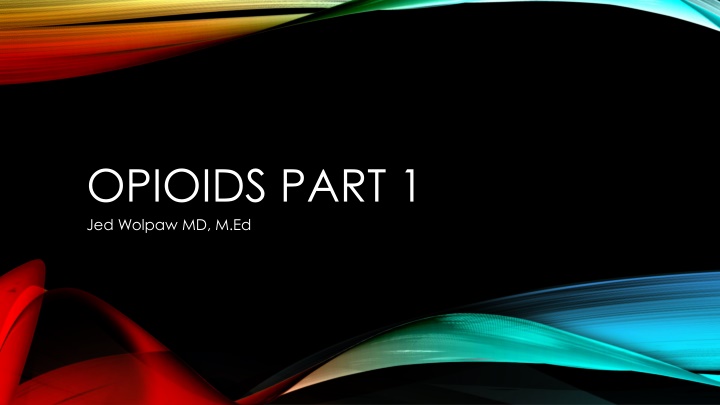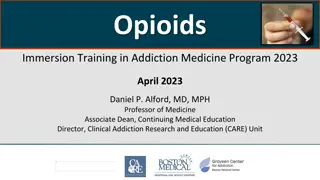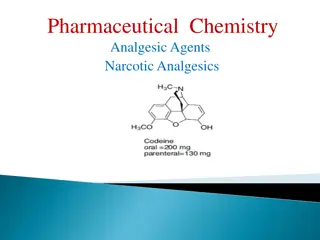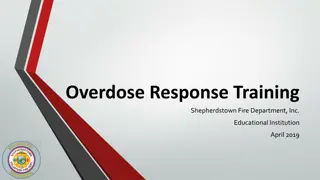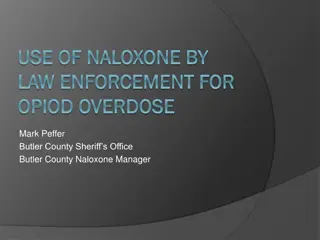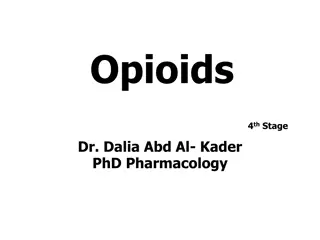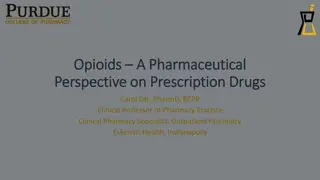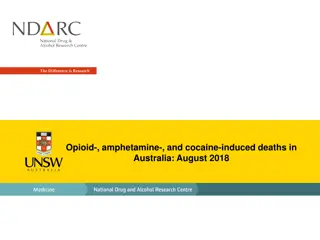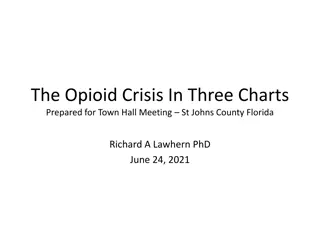Classification of Opioids and Their Mechanisms
In-depth analysis of opioid classification (natural, semi-synthetic, synthetic), receptors, endogenous ligands, mechanisms of action, mood alterations, CNS effects, and their impact on MAC. Images included.
Download Presentation

Please find below an Image/Link to download the presentation.
The content on the website is provided AS IS for your information and personal use only. It may not be sold, licensed, or shared on other websites without obtaining consent from the author.If you encounter any issues during the download, it is possible that the publisher has removed the file from their server.
You are allowed to download the files provided on this website for personal or commercial use, subject to the condition that they are used lawfully. All files are the property of their respective owners.
The content on the website is provided AS IS for your information and personal use only. It may not be sold, licensed, or shared on other websites without obtaining consent from the author.
E N D
Presentation Transcript
OPIOIDS PART 1 Jed Wolpaw MD, M.Ed
CLASSIFICATION OF OPIOIDS Naturally Occurring Morphine Codeine Papaverine Thebaine Semisynthetic Heroin Dihydromorphone, morphinone Thebaine derivatives (e.g., etorphine, buprenorphine) Synthetic Morphinan series (e.g., levorphanol, butorphanol) Diphenylpropylamine series (e.g., methadone) Benzomorphan series (e.g., pentazocine) Phenylpiperidine series (e.g., meperidine, fentanyl, sufentanil, alfentanil, remifentanil) Miller s Anesthesia 8th edition
RECEPTORS G protein coupled, 3 types: Mu, Delta, Kappa
ENDOGENOUS LIGANDS Delta: Enkephalin, Mu: -endorphin Kappa: dynorphin
MECHANISM OF ACTION Activation of receptors leads to expression of G proteins Inhibits Adenylate Cyclase reduces cAMP Causes reduction in voltage gated CA2+ channel and activation of inwardly rectifying K+ channel Neuronal excitability is reduced Leads to direct inhibition ascending transmission of pain signals from spinal cord dorsal horn and to activate pain modulating descending circuits from midbrain through medulla (rostral ventromedial medulla RVM) and PAG (periaqueductal gray) to dorsal horn
MECHANISMS OF MOOD ALTERATIONS Dopamine release in nucleus accumbens causes euphoria, reward Inhibition of panic, fear, anxiety pathways in locus ceruleus
CNS EFFECTS OF OPIOIDS Analgesia, drowsiness, changes in mood, mental clouding, usually not loss of consciousness Patients say pain is still present but they are more comfortable Better for nociceptive pain (transmitted through intact neural structures) than neuropathic pain (damaged neural structures)
EFFECT ON MAC Fentanyl can reduce MAC of isoflurane by 80%, sevo by 60-75% Interestingly, epidural fentanyl has more effect than intravenous People wake up at higher concentrations of ISO when given IV fentanyl than when given epidural fentanyl at the same rate Ceiling effect: after a certain dose won t lower MAC any more Also seen with EEG: won t get a dose dependent reduction leading to flatline like you will with inhaled anesthetics
EVOKED POTENTIALS For neuromonitoring Don t effect sensory or motor evoked potentials Do effect auditory evoked potentials
CEREBRAL BLOOD FLOW/ICP Usually cause small decreases in CMR and ICP or don t affect them at all Cause decreases in blood flow when combined with N20 Preserves CPP, mostly because of minimal effect on BP Can cause neuroexcitation, high doses can cause seizures Causes constriction of pupils through excitation of parasympathetic nerve to pupil
OPIOID INDUCED RIGIDITY Mechanism not fully understood Not direct action on muscle fibers Can be prevented or treated with nondepolarizing NMBs Can also be prevented or treated with benzos such as versed
PRURITIS Not from histamine release (non-histamine releasing opioids still cause it) Probably mediated by Mu receptor Reversed by naloxone Reduced by: Zofran Kappa agonists (pentazocine) Droperidol Propofol Gabapentin
RESPIRATORY EFFECTS: BENEFICIAL Prevent coughing except rapid bolus admin can cause cough Depress upper airway, tracheal and lower respiratory tract reflexes Prevent bucking and coughing with intubation when given 3-5 minutes before intubation and at doses of 3-5mcg/kg Fentanyl has some antimuscarinic and antihistaminergic properties, may help bronchospasm
RESPIRATORY EFFECTS: HARMFUL Decrease response to hypercapnia and hypoxia through Mu receptor action in brainstem respiratory center Apnea comes before unconsciousness Pts will breathe if told to Fentanyl cumulative doses above 20mcg/kg are predictive of need for post-op ventilation Can depress drive to breath for many hours Delayed/recurring respiratory depression Increased release from muscle into plasma with rewarming, shivering, motion etc. Miller s Anesthesia 8th edition
FACTORS AFFECTING RESPIRATORY DEPRESSION Dose Older age Other CNS depressants Renal insufficiency Hypocapnia Reduction of hepatic blood flow decreased clearance
CARDIOVASCULAR EFFECTS Hemodynamically stable unless dependent on high sympathetic tone Most cause bradycardia through central vagal nucleus except meperidine which can cause tachycardia Bradycardia can be exacerbated with concomitant use of B-blockers or CA2+ channel blockers Fentanyl, but not morphine, may have mild positive inotropic effects Can provide effect similar to ischemic preconditioning: protect myocardium, reduce infarct size Maintains O2 supply/demand ratio Enhances oculocardiac reflex Morphine and meperidine cause histamine release hypotension via vasodilation
ENDOCRINE EFFECTS Reduce stress response by inhibiting HPA axis Morphine and fentanyl prevent ACTH release and cortisol secretion Can reduce surgically induced hyperglycemia
TOLERANCE AND HYPERALGESIA Tolerance develops from long term use but also can happen with high dose short term remifentanil (0.3mcg/kg/min) Prevented or attenuated by use of NMDA blockers: ketamine, N20, methadone, Mg2+ Zofran and propofol may also attenuate opioid induced hyperalgesia Tolerance leads to lower pain threshold and hyperalgesia
OTHER EFFECTS Urinary retention Nausea, vomiting, inhibited gastric emptying, ileus Nausea/vomiting can be attenuated by propofol, Zofran, decadron, low dose naloxone infusion (0.25 mcg/kg/HOUR) (doesn t affect analgesia) Sphincter of Oddi spasm is not real, mildly increases biliary duct pressure Minimal to no effects on liver function Cross placenta, can cause neonatal depression but not teratogenesis Can attenuate increases in ICP from intubation and from sux
IMMUNITY AND CANCER Suppress natural killer (NK) cells Associated with greater rate of cancer recurrence Likely through immunosuppression and direct effects on cancer cells Cancer ERAS pathways try to limit or eliminate opioids
